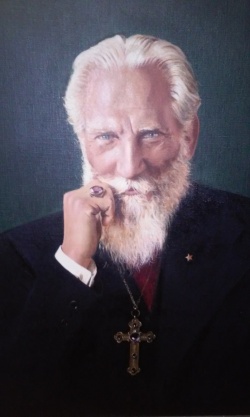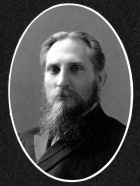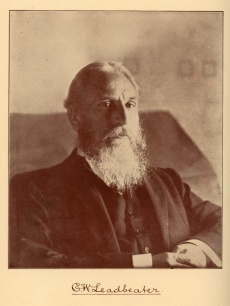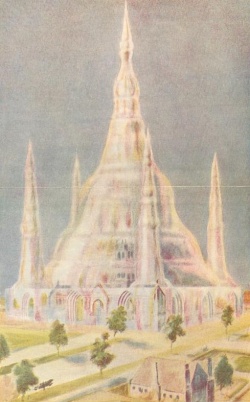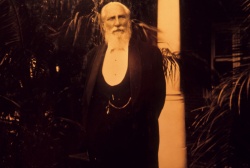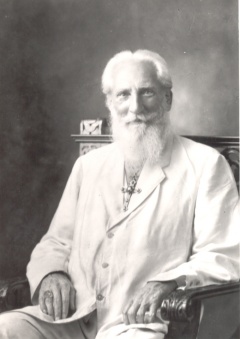Charles Webster Leadbeater
ARTICLE UNDER CONSTRUCTION
Charles Webster Leadbeater was an English Theosophist associated with the Theosophical Society based in Adyar, Chennai, India. He was best known for his extensive writings, his clairvoyant observations, and his involvement in the early life of Jiddu Krishnamurti.
Early life
Charles Webster Leadbeater was born in Stockport, Cheshire, England to Charles Leadbeater, a railway contractor's clerk, and his wife Emma. The date of his birth was February 16, 1854, and his christening took place on March 19, 1854.[1] the England Censuses of 1861 and 1881 confirm that year. However, beginning in the early 1880s, Leadbeater gave his birth date as February 17, 1847. That date appears in the 1891 census, in his passport, and is also reflected in passenger lists and other records. The earlier year, 1847, is the same year that Leadbeater's close associate Annie Besant was born.
According to C. Jinarajadasa, the Leadbeater family was Norman French in origin, with name Le Batre (the builder), later Englished to Leadbeater. One branch of the family followed "Prince Charlie of the Stuart dynasty and its custom was to christen the eldest son "Charles".[2]
In 1858 the family went to Brazil, and his father died a few years later, in 1862.
In December 21, 1879, following the footsteps of his uncle, Mr. Leadbeater was ordained a priest in the Church of England. However, he always kept an open mind for things that did not fall within orthodox Christianity, such as psychic and Spiritualistic phenomena. Whenever he heard of ghosts or haunted houses he conducted his own investigations. He also attended the lectures given by Annie Besant (then an atheist) at the Hall of Science.
Coming in touch with the Master
In 1883, Mr Leadbeater read a copy of A. P. Sinnett’s book The Occult World and became very interested in Theosophy. He met the author, who was at the time receiving letters from two of the Masters of Wisdom, and joined the London Lodge of the Theosophical Society, in November 1883. He was immediately attracted to the ideal of the Masters and felt that each "should set before himself the definite intention of becoming a pupil of one of the great Adept Masters".
One day, while investigating Spiritualistic phenomena with renowned medium and Theosophist William Eglinton, one of the latter's Spirit-guides named "Ernest" assured he could transmit a letter from Mr. Leadbeater to the Masters. On March 3, 1884, he wrote a letter to Master K.H. offering himself as a chela so that he could "learn more of the truth". He sent the letter to Mr. Eglinton, who placed it in a box he had for Ernest's use, and from which it eventually disappeared. Several months passed and he did not receive any reply.
In the meantime, he met Mme Blavatsky, who arrived at London on April and unexpectedly attended a rather troubled meeting of the London Lodge where new officers were being elected. He described the "truly tremendous impression" that Mme. Blavatsky had on him. Her plan was to stay in Europe until November 1st of that year, when she was to sail for India. On October 30, two days before her departure, Mr. Leadbeater traveled to London to say good-bye to HPB. He stayed the night with the Sinnett's. That evening HPB informed him that "D.K." had said that the Master had sent a reply to his letter of March 3rd. On the next day, Mr. Leadbeater returned to his house and found the Master's letter, which opened as follows:
Last spring--March the 3rd--you wrote a letter to me and entrusted it to "Ernest". Tho' the paper itself never reached me--nor was it ever likely to, considering the nature of the messenger--its contents have.[3]
In the letter the Master said that a member should "force" the Master to accept him as a chela by doing good works for humanity, working on self-purification, and making sacrifices for the Theosophical cause. He also warned CWL that he would have to atone for the collective karma of the Christian clergy to which he belonged. Finally, the Master suggested that he could go to Adyar to work for a few months. The letter closes with the following words:
So now choose and grasp your own destiny, and may our Lord's the Tathagata's memory aid you to decide for the best. K. H.[4]
He decided to follow the Master's suggestion. However, he found out he could not take a leave of absence from his position in the local Church school, of which he was manager--he had to resign to it. He decided to go back to London to talk to Mme. Blavatsky (who was leaving London the next morning) and, through her agency, ask the Master whether he wanted him to take this more drastic action. Late that night, in a gathering of some Theosophists that had come to say farewell to HPB, the answer was precipitated on her open hand, witnessed by several people. It said:
Since your intuition led you in the right direction and made you understand that it was my desire you should go to Adyar immediately – I may say more. The sooner you go the better. Do not lose one day more than you can help. Sail on the 5th if possible. Join Upasika at Alexandria. Let no one know you are going and may the blessing of our Lord, and my poor blessing shield you from every evil in your new life.
Greeting to you my new chela. K.H. Show my notes to no one.[5]
Your first instructor
The orthodox Brahmin Subba Row intentionally instilled distorted versions of esoteric philosophy and said plagues of H.P.B. because he repudiated that she gave Westerners the knowledge that he considered reserved for Brahmins. This marked Leadbeater a lot:
Subba Row related to us recently more concerning Madame’s remarkable complex character than I, at least, had previously known; and it shows us plainly how foolish it would be to blame her for what in anyone else would be called a want of common moral qualities. We were right in believing that the original H. P. Blavatsky, who was by nature clairvoyant and who had some knowledge of occultism, disappeared from earth life some twenty years ago, and that a certain Adept, who in some way had failed to reach his goal, voluntarily took possession of her body, or was placed there --- partly as a punishment, in order to do all in his power to promulgate the truth through her. We likewise understood rightly that when engaged on other business he was frequently absent from this body. But now I come to a point about which I was completely in error. I thought that during the absence of the Adept, the body was in a state similar to that of Margrave in Bulwer Lytton’s "Strange Story," only animated by its original lower constituents. But it seems this was not the case. At her death, all the usual constituents of the body left it as with that of others, and the present inhabitant had to supply the whole want from his own organisation. For this purpose two Chelas, but little versed in occultism, were selected to take the Adept’s place when necessary; and as no Adept or Chela can enter into a woman’s body during times of illness, at such times it had to be taken possession of by a terrible ill-tempered, ignorant old Tibet woman, in place of the Adept or Chelas, as she was the only female available for this purpose. It seems that when either of the four replaced one of the others, he or she had no idea of what had been said or done by the predecessor, and thus endless confusion occurred. This explains the fact that Madame so often contradicts what she had said a few hours previously, which fact naturally greatly excited Hodgson’s suspicions. It likewise accounts for the fact that sometimes she seems to know less about occultism than we ourselves do, while at others she speaks with the power and authority of a Rishi. For months together, in consequence of her various illnesses, the terrible old woman alone has inhabited her almost all the time, and all around her have suffered from her ill-temper. Still the Adept maintains his connection, in the hope, as we think, to be able to complete his promulgation of the "secret doctrine" through her. Whether this poor diseased body will hold together long enough for this purpose no one at present can predict. Of course this true explanation is useless for outsiders. But I think I can give even to them a satisfactory explanation of Madame’s contradictions without attributing intentional untruth to her, when I inform them that, as a Russian, she was prone to exaggeration, coupled with an unretentive memory and an excitable style of speaking; and especially when we consider that English is not her mother tongue and therefore she often makes mistakes. Poor old lady! her life has truly been a wonderful one, and who can say what will still come of it![6]
Leadbeater never visited Blavatsky when he returned to London and that was the goal of Subba Row, that people would lose faith in her.
Early Theosophical work
In 1886 Leadbeater was a member of the small headquarters staff at Adyar, along with President-Founder Colonel Olcott, A. J. Cooper-Oakley, and a few Indian workers. Very little money was coming into Adyar in those days apart from small incomes made selling books and coconuts. "When the [carriage] horses died one after another, for several months Mr. Leadbeater, as acting editor of The Theosophist had to walk the seven miles to Madras with proofs, etc."[7]
When Olcott founded Ananda College in Colombo, Ceylon (now Sri Lanka) on November 1, 1886, he installed Leadbeater as the first principal. While in Ceylon, Leadbeater served as General Secretary of the Theosophical Society in that country from 1888-1889.[8]
Accusations of pedophilia, expulsion and return to Society
In 1906, Leadbeater was accused of forcing adolescents, students under his education, to masturbate. Mary Lutyens gathered the testimonies of the students in the book Krishnamurti: The Years of Awakening, where she states that the children in question would have revealed these practices to their parents;[9] the Chicago Theosophical Society had addressed the same reproaches against Leadbeater.
In 1906 a commission of the American branch of the Society was appointed to investigate the facts of the pedophilia in which Leadbater was involved, but, before the meeting, the latter gave his resignation to "save society from shame" , as Henry Steel Olcott wrote.[10]
Leadbeater responded to the accusations by saying that the compelling adolescent sexuality would lead his students to have encounters with the prostitutes, and then to "protect" them taught them to periodically discharge the sexual energy through masturbation to avoid the karmic and moral consequences of the sexual relations according to him illicit with girls.
In the following years, Lutyens had to talk about the protection of Leadbeater's favorite students, some of whom slept with him in his own room and with whom Leadbeater would have had real sex.[11][12] Other members of society They accused of touching the genitals of a preadolescent child.
However, and the repetition of similar incidents over the years, none of the accusations against him led to legal proceedings or judicial decisions against Leadbeater, especially since they always managed to escape just in time. A judge in a custody case denounced in India (in relation to the legal guardian of Jiddu Krishnamurti and his brother Nityananda) noted in his regulation that Leadbeater was anchored to "immoral ideas". This led Annie Besant, friend and collaborator of Leadbeater, to carry out media coverage in the London Times.[13][14].
However, it was well known in the Theosophical Society that Leadbeater had a problematic and ambiguous relationship, especially on the sexual plane, with the young students he was dealing with. Later, in 1909, he was rehabilitated in the Theosophical Society as a result of the pressure of Annie Besant, who had become president after intense struggles in the organization, having exercised it over the other members.
International lecture tours
Krishnamurti
In May, 1909, C. W. Leadbeater ran into 13-year old J. Krishnamurti who was playing in the beach, exhibiting "the most wonderful aura he has ever seen, without a particle of selfishness." Although Theosophist and scholar Ernest Wood, who had tried to help the boy with his homework, considered him to be dim-witted, Leadbeater predicted that Krishnamurti would become a spiritual teacher and a great orator "much greater" than even Annie Besant.[15]
CWL nourished, educated and trained young Krishnamurti, who gradually began to resent the discipline imposed on him. As he became a teenager and left Adyar to live in Europe, he grew rebellious about his supposed spiritual role, and their relationship got more distant. But in 1922 this changed.
J. Krishnamurti arrived to Sydney in April to attend the Australian National Convention. There, he saw again CWL after about ten years. He wrote in a letter to Lady Emily C.W.L. was "just the same", and added: "He is much whiter in hair, just as jovial & beaming with happiness. He was very glad to see us. He took my arm & held on to it & introduced me to all with a 'voilà' in his tone. I was very glad to see him too."[16]
During one of the meetings at the Convention an argument broke out concerning Leadbeater. J. Krishnamurti, who was present, declared that he knew Leadbeater better than most of those present, and that he could speak with some authority. As he reported later, he then declared that CWL "was one of the purest and one of the greatest men I had ever met. His clairvoyance may be doubted but not his purity."[17]
After Krishnamurti left Australia he began to meditate and regain his touch with the Masters, as a result of which he had a a life-altering experience. After this he wrote to CWL:
I began consciously and deliberately to destroy the wrong accumulations of the past years since I had the misfortune of leaving you. Here let me acknowledge with shame that my feelings towards you were not what they should have been. Now, they are wholly different, I think I love and respect you as mighty few people do. My love for you when we first met at Adyar has returned bringing with it the love from the past. Please don't think that I am writing mere platitudes and worn out phrases. They are not and you, my dearest brother, know me, in fact better than myself. I wish, with all my heart, that I could see you now.[18]
Liberal Catholic Church
UNDER CONSTRUCTION
UNDER CONSTRUCTION
Leadbeater’s clairvoyant abilities shaped the development of the LCC. In 1920 he published The Science of the Sacraments, which described the astral forms that he saw when the Christian sacraments were performed. He found the Eucharist, or mass, to be particularly powerful. “It is a plan,” he wrote, “for helping on the evolution of the world by the frequent outpouring of floods of spiritual force.” When properly enacted, he said, the ceremony created an astral “thought-edifice” that can take on any number of variations, although it is usually based on a foursquare ground plan surmounted with a dome. To create as powerful a vehicle as possible, the celebrant needs to perform the Eucharist correctly and with intention (as opposed to rote mechanical enactment). The Catholic and Anglican rites of Leadbeater’s day were, he said, defective, so he and Wedgwood recast them. “We set to work to eliminate the many features which from our point of view disfigure and weaken the older liturgies,” James Ingall Wedgwood later wrote. “References to fear of God, to His wrath and to everlasting damnation were taken out, also the constant insistence on the sinfulness and worthlessness of man.” The resulting liturgy was published in 1919.
Years at The Manor
Return to Adyar
In 1929, Annie Besant wrote:
My Brother Leadbeater, after nearly 16 years' residence in Australia, has returned to Adyar to make his home here as of yore. For several years he has been living in Australia for nine months and making a three months' trip to Adyar. Now he retires to reverse that process. I am happy to have him with me again, for he is always a tower of strength and a fount of wisdom.[19]
Writings
Mr. Leadbeater wrote an extensive body of work, which is listed in Leadbeater writings. Often he collaborated with Annie Besant in writing about esoteric subjects. Young people such as Basil Hodgson-Smith and Fritz Kunz assisted with his massive correspondence, and Ernest Wood helped to compile some of the books.
Later years
He passed away on March 1, 1934 in Perth, Western Australia.
Honors and awards
Ananda College in Colombo, Sri Lanka awards the C. W. Leadbeater Challenge Trophy in honor of the first principal of the school.
The large 3-story residential building for visitors at Adyar is called Leadbeater Chambers. It was the first concrete building of its size in India, and the cornerstone was laid March 17, 1910 by Annie Besant.
Notes
- ↑ England, Select Births and Christenings, 1538-1975.
- ↑ Curuppumullage Jinarājadāsa, The "K. H." Letters to C. W. Leadbeater (Adyar, Madras: The Theosophical Publishing House, 1980), 53.
- ↑ Curuppumullage Jinarājadāsa, The "K. H." Letters to C. W. Leadbeater (Adyar, Madras: The Theosophical Publishing House, 1980), 12.
- ↑ Curuppumullage Jinarājadāsa, The "K. H." Letters to C. W. Leadbeater (Adyar, Madras: The Theosophical Publishing House, 1980), 14.
- ↑ Curuppumullage Jinarājadāsa, The "K. H." Letters to C. W. Leadbeater (Adyar, Madras: The Theosophical Publishing House, 1980), 52.
- ↑ Letter written by Leadbeater in 1885, cited in Light (London), March 2, 1901, p. 103.[1]
- ↑ C. Jinarājadāsa, "Administration of Adyar Headquarters," The American Theosophist 36.5 (April, 1947), 73-75, 82.
- ↑ "General Secretaries". The Theosophical Year Book, 1938. (Adyar, Madras, India: Theosophical Publishing House, 1938), 152.
- ↑ Mary Lutyens, Krishnamurti: The Years of Awakening, p.13. New York, Farrar Straus and Giroux, 1975.
- ↑ Lutyens 1975, p.16.
- ↑ Lutyens 1975, p.202.
- ↑ Peter Washington, Madame Blavatsky's Baboon, Secker and Warburg, Londra, 1993, pp.116-118, 121-123.
- ↑ «Naranian vs. Besant», lettera scritta da Annie Besant al Times, 2 giugno 1913, p.7.
- ↑ Kersey, John. 'Arnold Harris Mathew and the Old Catholic Movement in England 1908-52. p.199.
- ↑ Mary Lutyens, Krishnamurti: The Years of Awakening (New York: Farrar, Straus and Giroux, 1975), 21.
- ↑ Mary Lutyens, Krishnamurti: The Years of Awakening (New York: Farrar, Straus and Giroux, 1975), 140.
- ↑ Mary Lutyens, Krishnamurti: The Years of Awakening (New York: Farrar, Straus and Giroux, 1975), 143.
- ↑ Mary Lutyens, Krishnamurti: The Years of Awakening (New York: Farrar, Straus and Giroux, 1975), 160.
- ↑ General Report of the Theosophical Society, 1929, page 21-22.
Online resources
Articles and pamphlets
- An Appreciation of C. W. Leadbeater by Geoffrey Hodson
- C. W. Leadbeater - A Great Occultist Compiled by Sandra Hodson and Mathias J. van Thiel
- C.W. Leadbeater in Retrospect By Hugh Shearman
Additional resources
- CWL World
- Articles by and about C.W. Leadbeater at Katinkahesselink.net
